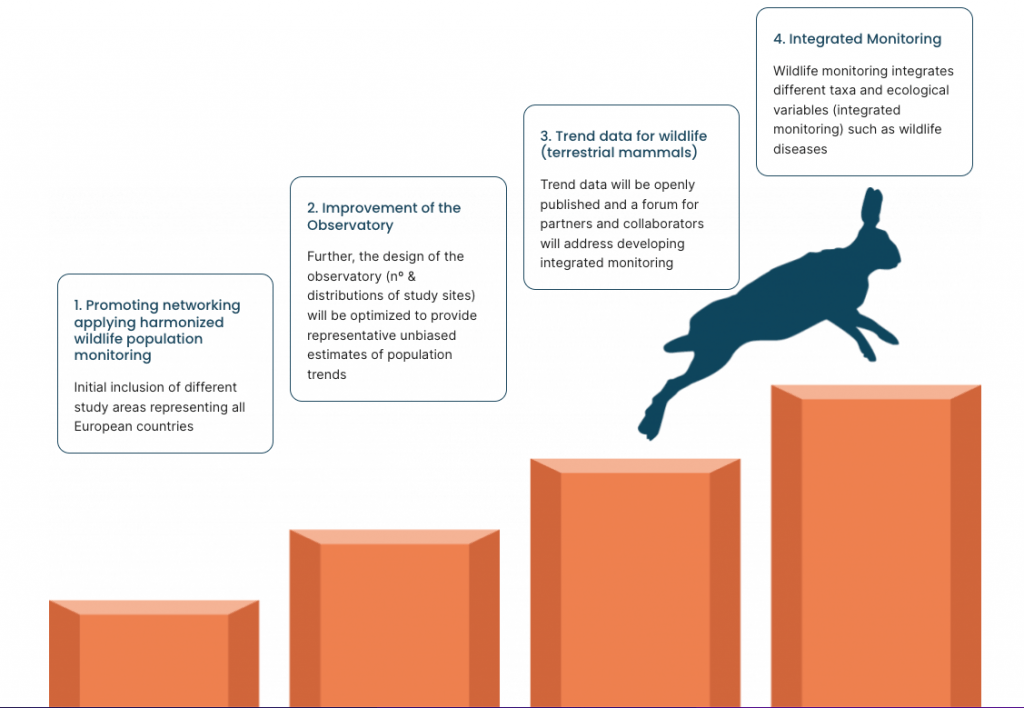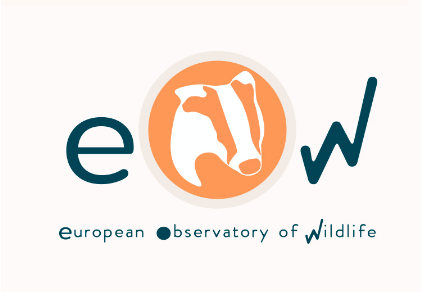Join a network of “observation points” with common wildlife population estimation protocols and data collection standards to facilitate harmonization and interoperability over Europe
The importance of wildlife monitoring for management at European scale
Europe represents an enormous socio-political and natural diversity where wildlife management is not only confined to reserves and does not only deal with protecting endangered and threatened species, their habitats, and removal of invasive alien species. Wildlife management, as well, deals with non-threatened agricultural animals and common species in farmlands and urban areas.
To apply an effective wildlife management, it is essential to follow trends in wildlife populations and their associated impacts and public acceptance. Wildlife monitoring is key to determine the nature of changes, their causes, and possible mitigating actions.
However, with few exceptions, true wildlife management in Europe is applied, and current management and monitoring efforts are not always harmonized among countries, institutions, and stakeholders. In addition, factors that govern wildlife distribution, abundance, their impacts, and disease spread are not bound by national borders. Clearly, the lack of comparable data among European countries represents a huge obstacle in the implementation of a common and more effective wildlife management.
Information and data flow needs the establishment of harmonised procedures/protocols and guidelines for wildlife monitoring and data formats for national and international administrations, but also for existing monitoring frameworks on geographic-based biological data.
Our approach: A European network for wildlife monitoring
In this scenario the European Food Safety Authority (EFSA) is funding the new-born European Observatory of Wildlife (EOW) (https://wildlifeobservatory.org/) as part of the ENETWILD project (www.enetwild.com). The main aim is improving and complement the European capacities for monitoring wildlife populations. The collection of comparable population data at European level is essential to conserve wildlife and manage wildlife-related conflicts, but the same data are also needed to analyse risks of spread of diseases shared between wildlife, livestock, and humans in a One Health context.
The EOW is therefore conceived as a European network of “observation points” with common population estimation protocols and data collection standards to facilitate harmonization and interoperability.
- The aims of the EOW are to provide:
- Guidance on density estimation methods and protocols
- Support and training, facilitating field design, data processing and analysis
- Independent information on wildlife population abundance and trends over time at European level
- Initially, the EOW prioritizes the inclusion of different study areas representing all European countries and bioregions (see figure below)
- Further, the design of the observatory will be optimized to provide representative unbiased estimates of population trends
- The approach is Integrative, Interdisciplinary, multi-sectoral, multi-institutional wildlife monitoring, initially focused on terrestrial mammals, and willing to meet other wildlife monitoring frameworks under One Health Approach in Europe
- Monitoring applying systematic and rigorous protocols, however, not at odds with the fact that it can be applied routinely and easily

Become a member of the European Observatory of Wildlife
The proposal herein presented to you/your Institution consists of becoming part of the EOW, as a formal collaborator. The conditions of this collaboration would be detailed in a “Agreement” document. Basically, the EOW provides to collaborators:
- Online training on the methods and protocols
- Protocols to estimate wildlife density based on camera trapping without need of capture/recapture. Other density estimation methods can be validated according to ENETWILD guides (https://enetwild.com/2020/11/23/wildlife_abundance_guide/, see also https://wildlifeobservatory.org/guides-and-population-density-cards)
- Continuous assessment on study design, implementation in the field, data processing and analysis
- Update on new developments of methods so as new tools for data processing and analysis. Information Technology tools (ITs), including artificial intelligence (AI) for image processing and a user-friendly online platform for data analysis, will be available by Summer 2022
- Participation in our networking activities
The collaborators contribute to the EOW:
- Providing details of the study area/s to make the choice jointly with ENETWILD
- Implementing the field protocol and developing fieldwork in the study area
- Processing and analyzing data following the indications of the project
- Reporting activities according to the ENETWILD schedule
Please find detailed instructions to become a collaborator here: https://wildlifeobservatory.org/instructions
We really believe this collaborative approach is both of benefit to collaborators and to the whole community and stakeholders that monitor, conserve, and manage wildlife in Europe, and of course, to the European society. Your work and contribution will be done in a framework where data will be comparable, interoperable, and results openly accessed. In addition, networking will allow continuous exchange of experiences and optimization of efforts. To sum, you will contribute and be in the forefront of wildlife monitoring at international level.
In case of positive response, we will contact you soon for further details. Please, do not hesitate to ask us any question that may arise at this stage.
We look forward to receiving your answer and hope a fruitful collaboration in the future for the sake of coordinated wildlife conservation and management in Europe.

